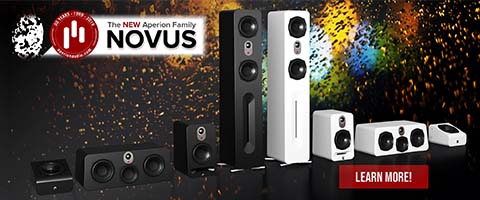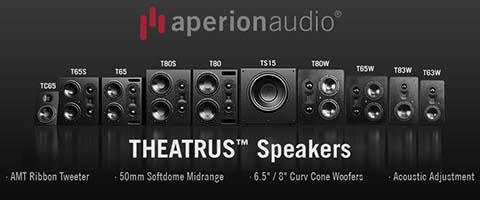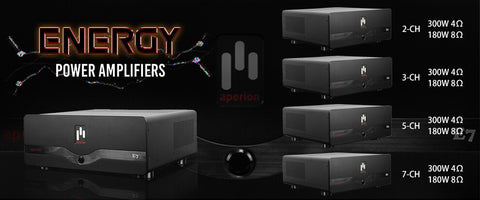Impedance, it’s a fairly straight forward concept, all electrical circuits and components resist the flow of electricity (or current) to some degree and the way we measure that resistance is impedance. The unit of measurement of impedance is ohms, often symbolized by the Greek letter omega: Ω. All pretty simple, right? Well, there’s still many misconceptions around the topic of impedance when it comes to speakers. The biggest of which is that your receiver’s impedance is something that you need to keep in mind when you are buying speakers. The truth is, since your receiver is the source of power in your system, its impedance is negligible. There isn’t sufficient circuitry or components between where the power is being amplified inside your receiver to the speaker outputs for any significant impedance to build up. So when people ask “how do I match the impedance of my receiver to my speakers”, they aren’t really asking the right question.
A Quick Intro to Speaker Impedance
Now speakers on the other hand, do in fact have measurable impedance because of the crossover network and the impedance of the drivers themselves. If you’re shopping around for speakers and take a look at the specs, you’ll notice that most speakers are rated between 4 and 8 ohms. Since impedance is a measure of how much the speaker resists current, the lower the impedance in ohms, the more power the speaker will draw from your receiver. Because of that, a 4 ohm speaker is considered more “power hungry” and will tax your amp more than a 6 or 8 ohm speaker. Since a 4 ohm speaker takes more power than an 8 ohm speaker, you may be wondering why anyone would design a 4 ohm speaker. To answer that question we need to dig a little deeper into what it really means when we label a speaker as “4 ohm” or “8 ohm”.
- - - - - - - - - - - - - - - - - - - - - - - - - - - - - - - - - - - - - - - - - - - - - - - - - - - - - - - - - - - - - - - -
Speaker Impedance is Really Just an Average

The reality is that a speaker’s impedance will actually vary quite widely depending on which frequencies it is producing. There are a few reasons for this, but there are two main factors. First, every driver has a resonance frequency at which it moves freely once it is tapped or otherwise engaged. At that frequency the free movement of the driver generates what is known as “back electromotive force” which opposes the flow of current and creates a large spike in impedance. The other reason for impedance variance is an increase in inductance of the voice coil at higher frequencies which also causes the impedance to go up. To illustrate this, take a look at the impedance graph of our Verus II Grand Bookshelf. There are three big impedance peaks in the graph, which correspond to the resonance frequencies of the port, woofer and tweeter moving left to right. Then on the right hand side of the graph you can see a gradual rise as the frequencies get higher due to inductance. Looking at the graph one thing should be clear, there’s a wide range of impedance values across the speaker’s frequency response, which is true for nearly all speakers. So when we say that the speaker’s impedance is “6 ohms”, what do we mean? Well if you look closely, you can see that the impedance only dips below 6 ohms ever so briefly around 200 Hz. For the rest of the frequency response, the impedance is well above 6 ohms. Because of that, we can say the speaker has a “nominal” impedance of 6 ohms. That is, the speaker’s impedance will not be below 6 ohms for the vast majority of the time. For further reading, you can check out more technical details behind speaker impedance here.
So going back to the original question, why did we make a 6 ohm speaker when we could have just designed an 8 ohm speaker and had it draw less power? The honest truth is that we would have had to make sacrifices in terms of sound in order to get the impedance higher. Which is more important, a speaker that we feel delivers the signature Aperion sound that our customers know and love, or a speaker that is slightly easier to drive? Of course we chose sound as the most crucial attribute for our speakers. The thing is, there really aren’t any hard and fast rules when it comes to nominal impedance. I have no doubt that there are in fact speakers out there that are labeled as “8 ohms” that have impedance graphs with dips the same or more severe as our curve. Here at Aperion, we like to be honest and not overstate specs, but of course the same can’t be said for every speaker manufacturer out there. Fudging specs aside, even a speaker that is unquestionable 8 ohms would not draw that much less power than our Verus II Grand Bookshelf. Especially when you consider that listening volumes are a much larger factor. Johnny Rocker who listens to his 8 ohm speakers at 110 dB is absolutely taxing his amp more than someone listening to a 6 ohm speaker at a reasonable volume.
- - - - - - - - - - - - - - - - - - - - - - - - - - - - - - - - - - - - - - - - - - - - - - - - - - - - - - - - - - - - - - - -
The Receiver Impedance Setting

Wait, my receiver has an impedance setting? I thought you said my receiver doesn’t really have any significant impedance? That’s absolutely correct! So then, just what is that impedance setting in your receiver doing? You may be shocked to learn that the only thing setting your receiver impedance to 4 ohms does is to lower the receiver’s maximum power output. Yep, that’s right, by going with the lower impedance setting you are actually telling your receiver to hold back the juice and are reducing the overall performance of your system. For that reason, we recommend going with the higher impedance setting in just about every case. You paid good money for your receiver, you may as well get all the power that it can provide. Now there are some extreme cases where you may have a speaker that can dip down into sub 4 ohm impedance for significant portions of their curves. In those rare cases, you may want to actually go with the 4 ohm setting. However, with most modern receivers if the speakers are really trying to draw more power than is available, the receiver will usually go into protection mode and shut off before it, or the speakers, start melting down.
- - - - - - - - - - - - - - - - - - - - - - - - - - - - - - - - - - - - - - - - - - - - - - - - - - - - - - - - - - - - - - - -
It’s All About the Current Capability
Instead of getting lost in the weeds with the impedance spec, it’s better to take a step back and look at the most important thing your receiver provides and your speakers need; power. If you have a receiver that is a high current design capable of delivering 100 watts/channel or better without distorting, you don’t have anything to worry about in regards to under-powering a speaker that is rated at 6 or 8 ohms. Another thing to keep in mind when considering power is that there are actually two components to a watt, current and voltage. The voltage is what the receiver gets from the wall outlet, but it’s the current that feeds your speakers. A high quality receiver will deliver consist levels of current, cleanly and without introducing unacceptable levels of noise or distortion. How can you tell if a receiver is honestly rated and capable of delivering the current your speakers crave? Good question, that’s a topic we’ll take a deep dive into in next week’s blog, see you then!

Complete Your Sound System Solution

Sign up for our newsletter below, and join our social media groups to stay up to date with the latest news and information from Aperion Audio!
 |
 |









 https://www.aperionaudio.com
https://www.aperionaudio.com
5 comments
I have two Kappa Infinity 100 speakers hooked up to a pre amp Yamaha a-s 2000 and a Rotel rb-1572 as an end amp. Still the Yamaha keeps shutting down alot. But the speakers are hooked up to the Rotel. What could be going wrong? I know the speakers will drop to 2 ohm on occasion. Could the Rotel and Yamaha not be sufficient enough for the 100’s? I need an amp that can take on the 100’s. Is the Mark Levinson 535H (5 channel) enough to take them on? Hope to hear from you. Gerben
“The voltage is what the receiver gets from the wall outlet, but it’s the current that feeds your speakers.”
Voltage?
You mean power?
Right?
“A high quality receiver will deliver consist levels of current”
Current?
You mean power?
Right?!?!
An amplifier has a minimum impedance because of the components Current/voltage capability used inside.
Choose one,
high voltage or high current?
You don’t get both!
@Tom: No. It will work fine :-)
sounds like laser galvose
I just bought a YAMAHA RX-V4A 80 watts er channel receiver. It has ohm settings of 6 or 8. So I checked my 633T speakers and the say 4Ohms. Can the 80 watt receiver drive my 4 ohm speakers or will the receiver melt down.
Thx
Tom